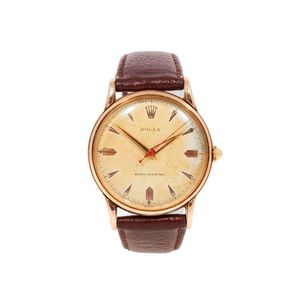Limited Antique Gold Plated Wristwatch with Moon Phase Calendar
You must be a subscriber, and be logged in to view price and dealer details.
Subscribe Now to view actual auction price for this item
When you subscribe, you have the option of setting the currency in which to display prices to $Au, $US, $NZ or Stg.
- Moon Dial - If we imagine life in the 17th century, the only source of ascertaining the time of day or night would have been the local church or municipal clock striking every quarter hour, and able to be heard by all in the village. In England, when longcase clocks became popular and more affordable in the late 17th century, the function of timekeeping and source of time was moved to within the home.
An additional feature on some longcase clocks was to display the phases of the moon, that is the new moon, the full moon and the waning moon over the lunar 29 ½ day cycle. This information was important for farmers for working out cropping schedules; for travellers to know the amount of moonlight on a night they planned to travel; and for those who lived near the sea required knowledge of the tides.
Where included, the moon dial is usually in the form of a disc incorporated into the main dial plate, usually in the arched top section. The lunar cycle starts with the new moon displaying, which is a dark night sky and no man-in-the-moon face being displayed, and then progresses to the full moon face showing on the 15th day of the lunar cycle, and back to no face displaying as the moon wanes. Most lunar dials are partially concealed on each side of their opening in the main dial plate by semi-circular "humps" that allow the painted face to emerge slowly just as the real moon goes out of and back into the earth's shadow.
Nowadays, details of the lunar cycle is published in diaries, almanacs, and newspapers and although some modern longcase clocks are still manufactured with working moon dials, they are more for decoration than for use. - Sterling Silver - Sterling silver is a mixture of 92.5% pure silver and 7.5% of another metal, usually copper. Fine silver is 99.9% pure silver, and is relatively soft and the addition of the very small amount of copper gives the metal enough strength and hardness to be worked into jewellery, decorative and household objects.
- Baton Numerals - A watch that instead of displaying numerals on the face, displays a marker in the form of a baton, or lower case letter "L". Since the baton-like marks are not numerals, the feature is also called baton markers, baton indexes and baton indicators.
- Date Aperture - A date aperture is a cut out section in the face of a watch or clock, displaying the day of the month.
- Movement - The technical name for the workings of a clock or watch, and does not include the dial or case.
This item has been included into following indexes:
Visually similar items

Patek Philippe, an 18ct white gold wristwatch ref 3802/200 mvt 3016548 mvt 3016548 Calatrava made in 2000, Cal.315/190 automatic winding movement, fully jewelled, adjusted to heat, cold, isochronism and 5 positions, gold rotor, white dial with black Roman

Rolex, gold Shock-Resisting wristwatch, c. 1950, manual winding movement, 9ct gold case, honeycomb cream dial with gold baton indexes and centre seconds, dial signed, replacement crown and bracelet, diameter 34 mm (case)

A gentleman's stainless-steel Manufacture Worldtimer wristwatch, Frederique Constant, circa 2000's. Automatic. 42 mm. Ref. FC-718MC4H6. Serial number 547/1888. Circular silver toned guilloche dial with roman numerals. Date subdial at 6 o'clock. Crystal sap

A Gentleman's stainless steel El Primero Flyback chronometre wristwatch, Zenith. Automatic. 42 mm. Ref. 03 1240 4001, Cal.4001. Circular case with silvered dial, applied Roman numerals, centre sweep seconds, triple calendar and moon phase. Case, dial, move
